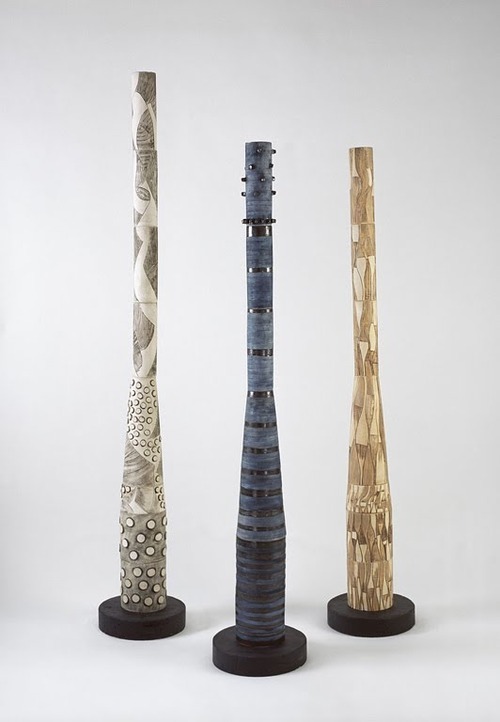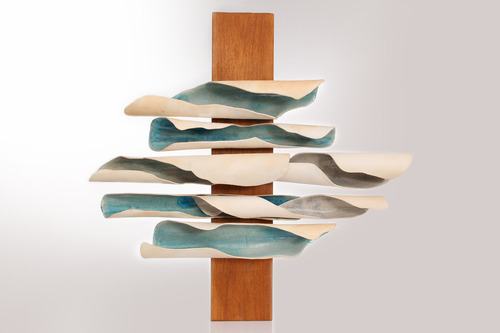
As a contemporary artist with extensive knowledge in the field of ceramics, can you share with us a significant experience for your career?
There is no doubt that growing up in a family of artists had a major influence on my life and artistic career. The chance to develop myself in an artistic environment, to be in contact with different genres of art, cultivated my taste for diversity. As a defining experience, I can say that the time spent in the ceramics studio during high school was the most interesting for me. In that period, the studio was an experimentation lab and I was encouraged by my teacher, Judita Crăciun, to discover new things, and so I gathered knowledge that further helped me build my artistic identity. A similar stage was during doctoral studies when I had the opportunity to reshape and enrich my knowledge and vision regarding ceramic art.
What inspires you and how do you start a new project?
New projects usually occur after reflecting on certain subjects, items or concepts that caught my attention and which I want to integrate into the work. Other ceramic projects come as a response to a challenging and interesting thematic for a special event or exhibition. What I particularly like is to closely observe plants, animals and insects, and to study their surfaces with a special attention to the countless details, drawings, textures or structures. The miniature elements extracted from the vegetal and animal world are translated into my work through a personal alphabet of shapes. Besides this, in my work I often use details and anatomical fragments as inspiration. In some works, these fragments lose their original identity and transform into volumetric expressions and complex reliefs.
There is a visible preoccupation for texture in your work; how do you make it and how important is texture and surface for the message you want to send?
The decorative elements are completing the volumes and have an equal importance for the ensemble, the details becoming in this context a work by its own. The texture makes the work more pretentious and transforms it into an object that requires more time and close inspection in order to be discovered. The structures are completing the volumes with nature inspired shapes, vegetal and zoomorphic elements. These graphic traces, reliefs or applied elements on the works’ surface are growing together with the shape. Some of the reliefs are taking form in the process of constructing the work by pressing the material on textured surfaces, and other work surfaces are transferred by imprinting, cutting and etching, or by applying mixed glazes to the surface. It is a big pleasure for me to collect in my kit of tools items that can help me later on with my work. This kit, made over the years, consists of lots of items that are indeed a small treasure – a chest with instruments out of the ordinary and tools made by me for the purpose to obtain new textures and more complex patterns.
In 2010 you held a conference in Paris on the topic of Romanian contemporary ceramics. In this context, what can you say about the context of Romanian ceramics? Do ceramist artists have opportunities in Romania?
The presentation of Romanian contemporary ceramics was part of a larger project together with a Romanian contemporary ceramics exhibition with Cristina Popescu Russu as curator. The exhibition, held at the Romanian Cultural Institute in Paris, was one of the most important events for the Romanian contemporary ceramics in the recent years, being included in the program of the 44th General Assembly of the International Academy of Ceramics (International Academy of Ceramics – ICA). Fourteen artists attended the exhibition but 46 Romanian ceramists were promoted through the materials presented throughout the ICA events. Following this exhibition, new contacts were established between artists.
The visibility of Romanian contemporary ceramics, both nationally and internationally, plays an important role in creating a professional, competitive and creative-stimulating environment which can generate exchanges between renowned and emerging artists, and arise new opportunities for collaborations. Following the records of contemporary ceramists from different generations, with a very original vision in this field, we can notice big differences in the thematic approach, style and forming of ceramic material. The various concerns of the artists for materiality, color, scale or accuracy, and the simplicity of shape are building the identity of Romanian ceramic art. An overview of Romanian contemporary ceramics makes us notice the multimedialism, the interdisciplinary dimension of it, and the new forms and ways of artistic expression generated by new materials, techniques and technologies.

Romana Cucu Mateiaş, Waves, 2011, Stoneware, 950˚C, 50 x 50 x 10 cm.
You are a founding member of the Center for Research and Artistic Creation in Public Space: what are the goals of this research center and what are its current projects? Personally, do you have projects particularly conceived for public space?
The Center for Research and Artistic Creation Art in Public Space is one of the research centers of the National University of Arts in Bucharest. It was open at the initiative of Ms Professor Marilena Preda Sânc as part of the Mural Art Department at the Faculty of Decorative Arts and Design. The center is dedicated primarily to bachelor students, master students, doctorate students, teachers and artists interested in public art space. In this center, the main focus is making art projects in relation to a given environment and integrating the work of art in indoor or outdoor public spaces. Public Art projects are available through grants, exhibitions, conferences and publications. The Mural Art Department is currently running several projects involving particular mural art, and which will be implemented by undergraduate students. Interventions take place in public spaces being coordinated by teachers.
Regarding the personal work, I made a couple of ceramic sculptures and mural pieces that can be integrated in public or private, indoor or outdoor spaces, and also some Light Art installations.
What projects are you currently developing and what are your future plans?
I am currently preoccupied with creating a series of works that combine the ceramic techniques and Light Art. The installation will be built from small scale ceramic elements side by side, forming a rhythmic surface, a kinetic play of light and shadows. As future plans, I decided to translate some sketches and ideas that took birth during doctoral studies into ceramic projects, and to compose a solo show as a result.
Interview by Andra Baban, published in Ceramics Now Magazine, Issue 2.
Visit Romana Mateias’ website.
View the list of interviews with ceramic artists.




















